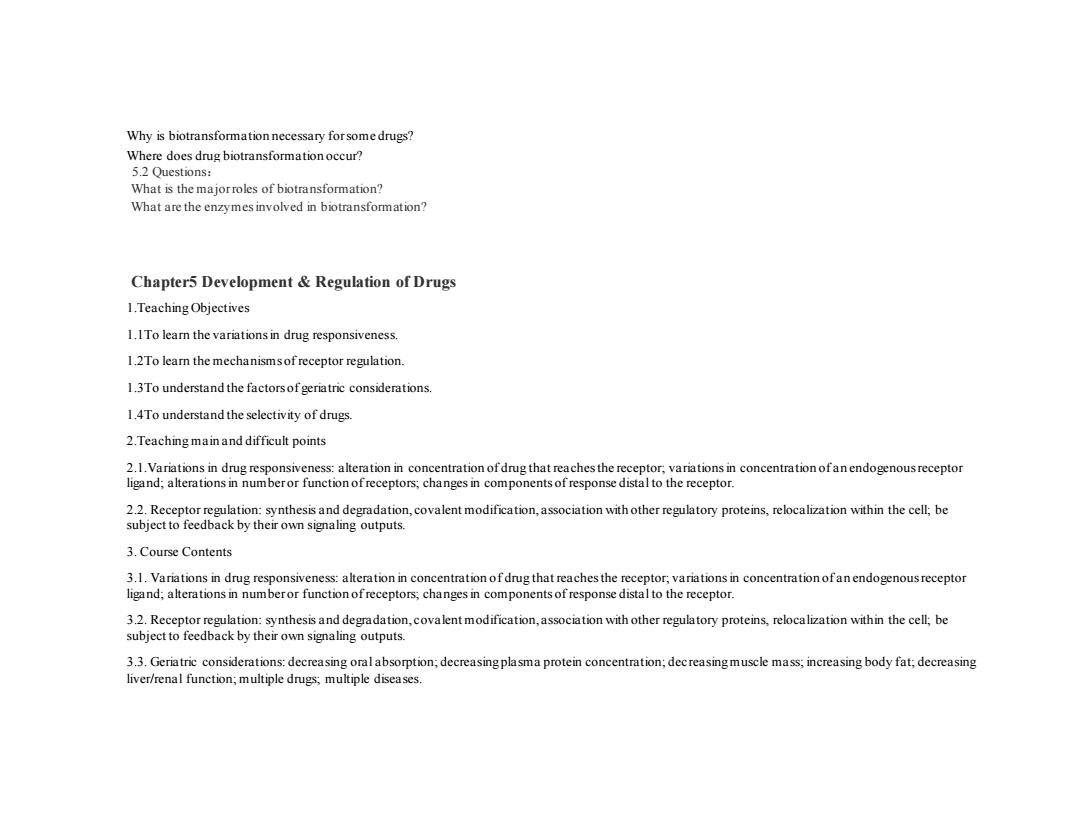正在加载图片...

Why is biotransformation necessary forsome drugs? Where does drug biotransformation occur? 5.2 Questions: What is the majorroles of biotransformation? What are the enzymes involved in biotransformation? Chapter5 Development Regulation of Drugs 1.Teaching Objectives 1.ITo learn the variations in drug responsiveness. 1.2To learn the mechanismsof receptor regulation. 1.3To understand the factors of geriatric considerations. 1.4To understand the selectivity of drugs. 2.Teaching main and difficult points 2.1.Variations in drug responsiveness:alteration in concentration ofdrug that reaches the receptor,variations in concentration ofan endogenous receptor ligand;alterations in numberor function ofreceptors,changes in components of response distal to the receptor. 2.2.Receptor regulation:synthesis and degradation,covalent modification,association with other regulatory proteins,relocalization within the cell;be subject to feedback by their own signaling outputs. 3.Course Contents 3.1.Variations in drug responsiveness:alteration in concentration ofdrug that reaches the receptor,variations in concentration ofan endogenousreceptor ligand;alterations in numberor function ofreceptors;changes in components of response distal to the receptor. 3.2.Receptor regulation:synthesis and degradation,covalent modification,association with other regulatory proteins,relocalization within the cell;be subject to feedback by their own signaling outputs. 3.3.Geriatric considerations:decreasing oral absorption;decreasing plasma protein concentration;decreasing muscle mass;increasing body fat;decreasing liver/renal function;multiple drugs,multiple diseases.Why is biotransformation necessary for some drugs? Where does drug biotransformation occur? 5.2 Questions: What is the major roles of biotransformation? What are the enzymes involved in biotransformation? Chapter5 Development & Regulation of Drugs 1.Teaching Objectives 1.1To learn the variations in drug responsiveness. 1.2To learn the mechanisms of receptor regulation. 1.3To understand the factors of geriatric considerations. 1.4To understand the selectivity of drugs. 2.Teaching main and difficult points 2.1.Variations in drug responsiveness: alteration in concentration of drug that reaches the receptor; variations in concentration of an endogenous receptor ligand; alterations in number or function of receptors; changes in components of response distal to the receptor. 2.2. Receptor regulation: synthesis and degradation, covalent modification, association with other regulatory proteins, relocalization within the cell; be subject to feedback by their own signaling outputs. 3. Course Contents 3.1. Variations in drug responsiveness: alteration in concentration of drug that reaches the receptor; variations in concentration of an endogenous receptor ligand; alterations in number or function of receptors; changes in components of response distal to the receptor. 3.2. Receptor regulation: synthesis and degradation, covalent modification, association with other regulatory proteins, relocalization within the cell; be subject to feedback by their own signaling outputs. 3.3. Geriatric considerations: decreasing oral absorption; decreasing plasma protein concentration; dec reasing muscle mass; increasing body fat; decreasing liver/renal function; multiple drugs; multiple diseases